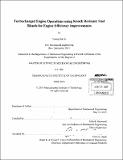| dc.contributor.advisor | John B. Heywood. | en_US |
| dc.contributor.author | Jo, Young Suk | en_US |
| dc.contributor.other | Massachusetts Institute of Technology. Department of Mechanical Engineering. | en_US |
| dc.date.accessioned | 2013-10-24T17:34:20Z | |
| dc.date.available | 2013-10-24T17:34:20Z | |
| dc.date.copyright | 2013 | en_US |
| dc.date.issued | 2013 | en_US |
| dc.identifier.uri | http://hdl.handle.net/1721.1/81606 | |
| dc.description | Thesis (S.M.)--Massachusetts Institute of Technology, Dept. of Mechanical Engineering, 2013. | en_US |
| dc.description | Cataloged from PDF version of thesis. | en_US |
| dc.description | Includes bibliographical references (p. 61). | en_US |
| dc.description.abstract | Engine downsizing with a turbocharger has become popular these days in automotive industries. Downsizing the engine lets the engine operate in a more efficient region, and the engine boosting compensates for the power loss accompanied by downsizing. However, the use of high boost in a downsized engine is limited by knock. Changing operating parameters such as spark timing has shown to be effective in avoiding knock. However, those strategies usually deteriorate efficiency of the engine. Another method to suppress knock without lowering efficiency is to use knock resistant fuels. Among them ethanol has gotten a large attention due to its renewable characteristics. About 13.3 billion gallons of ethanol were produced in 2012, and about 99 % of them are used as fuel added to gasoline. However, the optimal use of ethanol in a spark ignited engine as a knock suppressing additive is not well quantified. Also, operation limitations of a knock free engine are not well known. The objective of this project was to determine the knock onset engine operating conditions and to explore the potential of a direct injection of ethanol enhanced fuels. An engine with a turbocharger was used to measure efficiencies of the engine over the wide range of operating points. Speed range was chosen from 1500 rpm to 3000 rpm in which vehicle is usually driven in the driving cycle. Then, knock onset of different ethanol-gasoline blends, from 0 % ethanol to 85 % ethanol contents with 91 RON gasoline, were determined. Generated engine fuel consumption maps with knock onset limits were utilized in a vehicle driving simulation tool. In a simulation, the consumption of gasoline and knock suppressing fuels was determined in different driving cycles. Finally, effects of downsizig and spark retard on ethanol fraction in the fuel were determined. | en_US |
| dc.description.statementofresponsibility | by Young Suk Jo. | en_US |
| dc.format.extent | 61 p. | en_US |
| dc.language.iso | eng | en_US |
| dc.publisher | Massachusetts Institute of Technology | en_US |
| dc.rights | M.I.T. theses are protected by
copyright. They may be viewed from this source for any purpose, but
reproduction or distribution in any format is prohibited without written
permission. See provided URL for inquiries about permission. | en_US |
| dc.rights.uri | http://dspace.mit.edu/handle/1721.1/7582 | en_US |
| dc.subject | Mechanical Engineering. | en_US |
| dc.title | Turbocharged engine operations using knock resistant fuel blends for engine efficiency improvements | en_US |
| dc.type | Thesis | en_US |
| dc.description.degree | S.M. | en_US |
| dc.contributor.department | Massachusetts Institute of Technology. Department of Mechanical Engineering | |
| dc.identifier.oclc | 858869910 | en_US |
